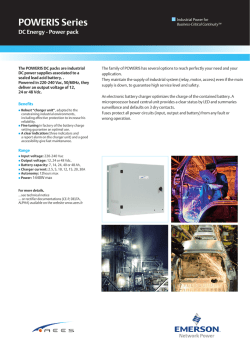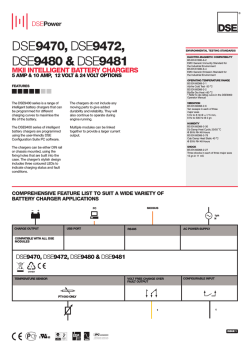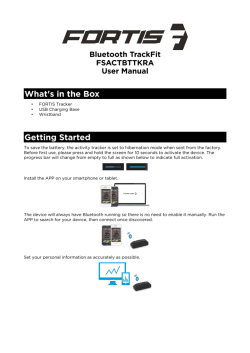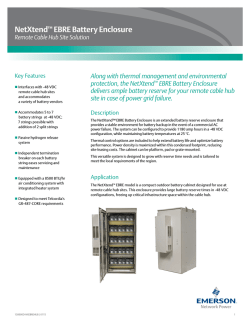
Electrolyte Manual_V1.2
Specs Required Wingspan: 508mm Length: 533mm Weight: 280~330g Motor: 2040 Inrunner 8000Kv 4 Channel Transmitter and Receiver 3S 11.1V 850~1300mAh Lipoly Battery 3 x Dymond D4.7g Servos 30A Brushless ESC Features Pre-painted molded fiberglass fuselage Balsa wing and tail from the factory Bifurcated inlet ducting pre-installed High visibility color scheme Full Flying Horizontal Stabilizer Choice of two different vertical fins included Dr. MadThrust alloy fan shroud with 8000kV motor included Easy access battery hatch Thank you for purchasing your HobbyKing Electrolyte 40mm EDF. We hope you enjoy assembling and flying it as we did creating it. Designed by Dr. Bret Becker, the Electrolyte has received a good following with members of the RC Groups forum community. First conceived in 2010, the design featured a fiberglass fuselage, solid balsa wings, and is powered by a 40mm micro EDF power system. It can reach speeds in excess of 100 miles per hour right out of the box. Tools Required 1 2 3 4 5 6 7 8 9 10 11 12 13 14 15 16 17 18 19 Ruler Clear Tape HobbyKing aircraft follow an extensive design, development, and testing process to bring reliable and user friendly products to the masses. They undergo extensive quality control checks at the factory. Please read this instruction manual thoroughly before assembling and flying this model. It is not a toy and if mistreated has the potential to inflict bodily injury or damage property. It is your responsibility to complete final assembly, setup, and routine pre-flight checks. Always make sure to check for any loose screws or parts, and that the airframe is free from damage that may cause failure in flight. HobbyKing is not responsible for any injury or property damage inflicted due to negligence in assembly or maintenance. Rotary Tool w/ Assorted Bits 1.5mm Drill Bit Hobby Knife Phillips Screwdriver Warnings Select your flying area carefully. Always choose an open space that is unobstructed from trees, buildings, and away from crowded areas. Avoid flying in areas with roads, electric or telephone wires, or close proximity to full size air traffic. Needle Nose Pliers Pliers Scissors Do not fly this model in poor weather including high winds, low visibility, rain, or thunderstorms. Never attempt to catch this model whilst in flight. Even a slow moving model can cause harm to yourself or others. Always unplug your model battery when not in use. Do not leave the battery installed in the model when not in use. Remain clear from the propeller at all times when the flight battery is connected. A spinnginpropeller can cause bodily injury. Before flying always turn ON your transmitter first, then connect your flight battery to the model. Required Items 25~30Amp Brushless ESC After flying, always disconnect your flight battery first, then turn OFF your transmitter. 2 CELL 3 CELL DC 1 3 x Dymond D4.7g Servos 11-18V Always exercise caution when charging batteries. Follow the recommended charging instructions from your battery manufacturer, and use a charger with charging parameters that match your battery type. Epoxy B TGY This model is recommended for children no younger than 14 years old. All children should always be supervised by a capable and responsible adult when operating this model. Epoxy A CA Glue 4 CELL 5 CELL Turnigy Charger MAIN MENU STOP 3S 11.1V 850~1300mAh LiPo DECREASE INCREASE STATUS 6 CELL START ENTER LiPo Charger 2 4+ Channel Transmitter + Receiver Airframe Assembly Stabilizer Assembly 1) Identfiy left stab with recess for control horn. 3) Glue horn to stab using regular CA. 5) Test fit flying stab with spacers. 2) Remove covering material where control horn is glued to stabilizer. 4) Attach center section of flying stab to fuselage using 4 screws. 1) Locate the servo cutouts in wing and cut away covering from the top and bottom. 2) Mount the wing to the fuselage, lining up the wing mounting holes to the fuselage. Using a black felt pen, mark the location for the aileron servo cutouts in the wing saddle. 3) Using a rotary tool, cut away wing saddle material from the marked location. This allows the wing servos to sit flush against the bottom of the wing. 4) Select which fin option you will use. Roughen fuselage at contact location with sandpaper or a rotary tool. 6) Roughen the area on each end of the brass tube that will be inserted into the stabilizer half. **Build Note** Apply epoxy to stabilizer halves only. Do not glue to center section. 5) Glue fin to fuselage with 15 minute epoxy, keeping the fin 90 degrees to the horizontal stabilizer. Spacers should touch stabilizer slightly, but not limit movement. 90° 7) Using 15 min epoxy, glue brass tube to left stab with control horn and allow to cure. Install left stab into center section with L & R spacers in place. Finally glue other stabilizer half. Set on flat surface with tips of both halves contacting the flat surface for alignment. 3 4 Wing Assembly 5) Install micro pushrods. Suggest placing the U-bend towards the wing surface to prevent catching upon landing. 8) Install landing skids on bottom of wing. These are a wear item and will need to be replaced periodically. 1) Use two hinges per aileron. Check that there are slots for hinges. Cut slots as necessary with a sharp hobby knife. Glue hinges first to aileron with thin CA. When dry, glue to wing, checking for even gap on aileron ends to ensure free movement. 6) Mount Bungee hook block by removing covering from top of the wing in shape of bungee hook block. Block should be even with front of wing. Glue in place with Epoxy. **Build Note** Mount may need to be tapered to properly clear the ducting. Check fit before gluing to the wing. 2) Trim micro aileron horn at 3rd ring (Barb) Prevents horn from protruding through top of wing. 3) Using a 1/16” (1.5mm) drill bit, drill a hole manually from the underside of the aileron. Use your finger placed on the top surface to prevent drilling through the covering **Build Note** Center servos and install control arms on servos prior to gluing into wing. 7) Screw in bungee hook from bottom. Hole may need to be drilled out for proper fit. A dab of epoxy can be used to further secure hook to block. 4) Glue micro control horns to bottom of wing, and aileron servos to wing using thick CA. 5 6 Fan Installation **Build Note** The performance of this model lies in attention to detail when installing the ducting. The templates below are rough estimates and may need slight adjustments to fit your exact model since each one is slightly different. Forward Duct Rear Duct 138mm 100mm 104mm 120mm 4) Test fit fan and ducting into fuselage. Back edge of fan shround will align to 3rd set of screw holes. (From back) ESC will mount on right side of fuselage, opposite the elevator servo. **Build Note** Aft tail mount blocks in fuselage may need slight bevel to allow rear ducting to be inserted without distortion 137mm 132mm 1) Using the templates above as guides, cut front and rear ducting pieces from the included clear plastic sheet. Each template above has excess material shown (beyond the dashed line) that helps to make taping the ducting together easier. Suggest 10mm for forward duct, and 8mm each side of rear duct. *Thrust Tube Exit Diameter* - 30mm Yields optimal speed - 33~34mm Yields better static thrust 2) Remove front lip piece from fan. This will not be used for the Electrolyte. 3) Using clear tape, tape together the ducting pieces. For tightest fit of rear ducting, roll it tightly around fan prior to taping. Make front and rear duct pieces. 7 5) Mount elevator servo to left fuselage side using 15 minute epoxy. Install servo arm and center servo before gluing to fuselage. 6) Using clear tape, carefully attach ducting to fan to make complete unit. Check your motor for proper rotation direction prior to installation. Route motor wires as shown, minimizing force on the wires to prevent long term damage. 8 Final Assembly 1) Attach elevator pushrod to servo and stabilizer 2) Attach wing to fuselage using four screws. as shown. Secure clevis with set screw. See note Feed aileron, elevator, and ESC leads under on page 11 for elevator setup. bifurcated inlet ducting into forward fuselage. 7) Carefully insert the full fan/ducting module into the model, spreading the fuselage to slip the fan past. Once the whole module is inserted, slide it forward overlapping by 3~4mm on front ducting. 3) Install receiver and battery, secure both with velcro. Refer to final setup below for CG. Setup 9) Apply 15 minute epoxy thickened with microballons to fan where it contacts the fuselage sides. High temp RTV silicone can be used as well should you need to remove the fan later **Setup Note** 2mm aileron throw is general recommendation. 4mm is ONLY for hand launching, no Bungee. 57mm (On Spar) Aileron 2~4mm 2~4mm Elevator 5mm 10) Hatch installed on fuselage with 4 screws 9 5mm 10 Setup 3mm **Setup Note** Set elevator neutral with small amount of up elevator. Center leading edge of stabilizer with bottom of the fuselage. This is approximately 3mm. First Flight 1) Before flying this model, check that the model is assembled per this manual and is free from any damage that may have occured during transport. 2) Insert flight battery, and check for proper center of gravity. Secure battery with velcro on the bottom of pack and velcro strap around it. If the battery shifts in flight it could cause a loss of control. Control Check 3) Ensure that pushrods and control surfaces move freely with no binding. For best results, disconnect pushrods and flex the hinges by hand to free up the hinges. Reconnect control rods prior to first flight. Up Elevator Down Elevator 4) After turning on the transmitter and then connecting the flight battery, perform a full range test, and then check control direction per the guide on previous page. 5) Conduct a full power test. 6) Inspect your flight location, making sure it is free from trees, vehicles, people, or other obstructions before taking off. Right Roll Left Roll 7) For bungee launching, stake bungee line into ground. Pull all slack from line, then walk additional 17~20 paces. This provides good launching power 8) Apply about 3/4 power, nose up, about 60~75 degrees, and let go. Do not push. **Launch Note** Wind direction is very important for a successful bungee launch. Cross wind launches are to be avoided at all cost. 11 12
© Copyright 2024





